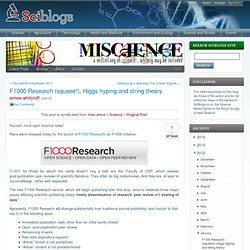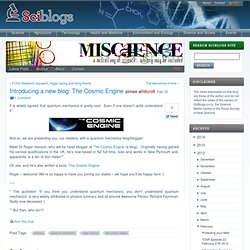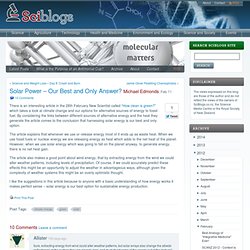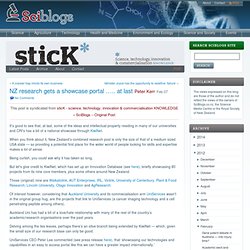

F1000 Research (squeee!), Higgs hyping and string theory. Huzzah, more open science news!

Gains in DNA Are Speeding Research Into Human Origins. Introducing a new blog: The Cosmic Engine. It is widely agreed that quantum mechanics is pretty cool.

Even if one doesn’t quite understand it*. And so, we are presenting you, our readers, with a quantum mechanics blog/blogger! Nature Publishing Group : science journals, jobs, and information. Functional Silk: Colored and Luminescent - Tansil - 2012 - Advanced Materials. Time-Lapse Map of Every Nuclear Explosion 1945-1998.
Solar Power – Our Best and Only Answer? There is an interesting article in the 28th February New Scientist called “How clean is green?”

Which takes a look at climate change and our options for alternative sources of energy to fossil fuel. By considering the links between different sources of alternative energy and the heat they generate the article comes to the conclusion that harnessing solar energy is our best and only option. The article explains that whenever we use or release energy most of it ends up as waste heat. When we use fossil fuels or nuclear energy we are releasing energy as heat which adds to the net heat of the planet. However, when we use solar energy which was going to fall on the planet anyway, to generate energy, there is no net heat gain. The 16 Best Science Visualizations of 2011. Toxic barbs on a cucumber’s skin, nanoscopic flakes of metal and a mouse’s technicolor eyeball (above) are just a few of 2011′s top science visualizations.A panel of judges picked the best of more than 200 entries from 33 countries for the 2011 International Science and Engineering Visualization Challenge.

“I think because information technology tools and visualization tools have advanced, people have found ever-increasingly clever ways to display difficult scientific concepts,” said competition judge Thomas Wagner, a cryosphere scientist at NASA, in an interview provided by the contest.Contest judges made their picks based on visual impact, originality and clarity. The winners, which include “people’s choice” awards as well as honorable mentions, were published online Feb. 2 in the journal Science.The entries weren’t just limited to photographs. Scientists close to entering Vostok, Antarctica’s biggest subglacial lake. To prevent a sudden release of gas, the Russian team will not push the drill far into the lake but just deep enough for a limited amount of water — or the slushy ice on the lake’s surface — to flow up the borehole, where it will then freeze.

Reaching Lake Vostok would represent the first direct contact with what scientists now know is a web of more than 200 subglacial lakes in Antarctica — some of which existed when the continent was connected to Australia and was much warmer. They stay liquid because of heat from the core of the planet. “This is a huge moment for science and exploration, breaking through to this enormous lake that we didn’t even know existed until the 1990s,” said John Priscu, a researcher at Montana State University who has long been involved in antarctic research, including a study of Vostok ice cores.
The extreme cold, which limited drilling time, contributed to the long duration of the project. Wonderful quotes about science. Why do some futurists like to create cute or quirky future occupations? Futurist Thomas Frey recently blogged about a talk he gave at a TEDx event — claiming 2 billion jobs will disappear by 2030.

He notes his purpose wasn’t to make the future seem bleak, but to highlight how technologies are changing the nature of work. He looks at five ‘industries’ to illustrate the types of jobs that may be lost and the types of new ones that may be created. The five are energy, transportation, education, 3D Printers, and robots. The latter two aren’t, of course, industries. Thomas suggests that robots will replace fishermen and farmers, while new vocations in fashion designers for robots will emerge.
There is value in highlighting the changing nature of work, but these top of the head speculations irritate me. Sure, most economies are increasingly reliant on technologies (and robots are replacing humans in a range of roles), but it is hard to predict how they will really affect the types of jobs in the future. NZ research gets a showcase portal ….. at last. It’s good to see that, at last, some of the ideas and intellectual property residing in many of our universities and CRI’s has a bit of a national showcase through KiwiNet.

When you think about it, New Zealand’s combined research pool is only the size of that of a medium sized USA state — so providing a potential first place for the wider world of people looking for skills and expertise makes a lot of sense. Being curlish, you could ask why it has taken so long. But let’s give credit to KiwiNet, which has set up an Innovation Database (see here), briefly showcasing 80 projects from its nine core members, plus some others around New Zealand.
Gene-Z: A Device for Point of Care Genetic Testing using a Smartphone. The Long, Strange Quest to Find a Substance that Kills Sexual Desire. Bubbly tastes best in a slim glass.